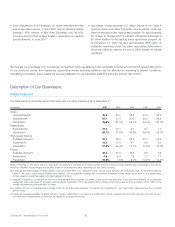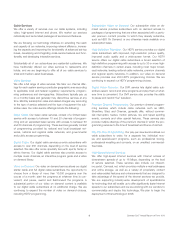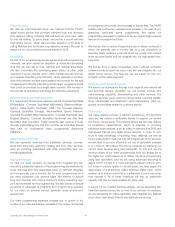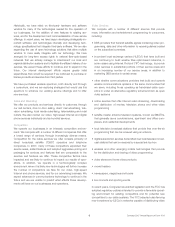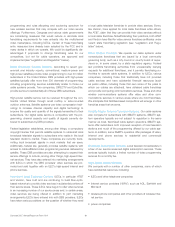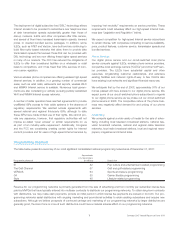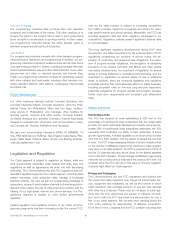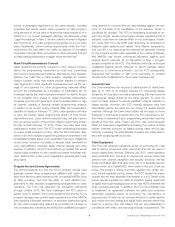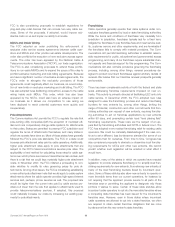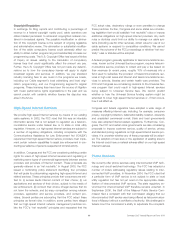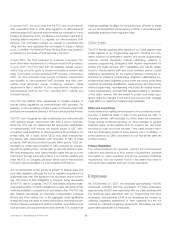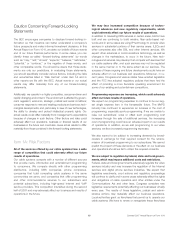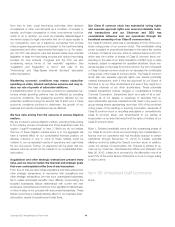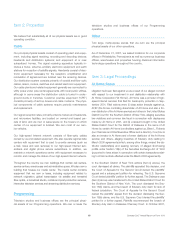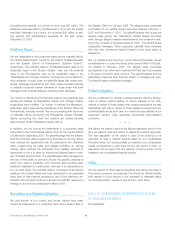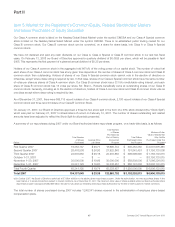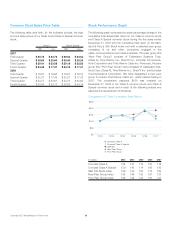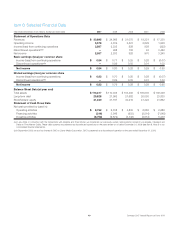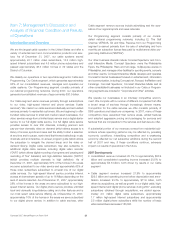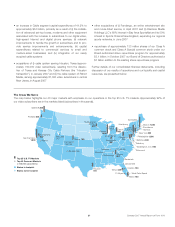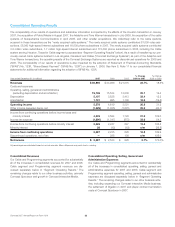Comcast 2007 Annual Report Download - page 14
Download and view the complete annual report
Please find page 14 of the 2007 Comcast annual report below. You can navigate through the pages in the report by either clicking on the pages listed below, or by using the keyword search tool below to find specific information within the annual report.
In January 2007, the court ruled that the FCC had not yet specifi-
cally preempted state or local utility regulation of cable-delivered
interconnected VoIP services and permitted the complaint to move
forward. In November 2007, the Missouri commission ruled that its
enabling statute required it to regulate our interconnected VoIP
services. The commission denied our request to reconsider that
ruling and we have appealed the commission’s ruling in federal
court. In addition, the Vermont Public Service Board has opened a
proceeding for the review of VoIP services in Vermont.
In April 2007, the FCC extended its customer proprietary net-
work information requirements to interconnected VoIP providers.
In June 2007, the FCC held that the disability access require-
ments that currently apply to telecommunications carriers also
apply to providers of interconnected VoIP services. In November
2007, the FCC extended local number portability requirements
and benefits to interconnected VoIP providers and their com-
petitive local exchange carrier numbering partners. These
requirements are in addition to prior requirements imposed on
interconnected VoIP by the FCC, including E911, CALEA and
Universal Service.
The FCC has initiated other rulemakings to consider whether to
impose further regulations on interconnected VoIP providers. For
example, in one rulemaking, it would impose on interconnected VoIP
(and telecommunications carriers) a 48-hour number porting interval.
The FCC and Congress are also considering how interconnected
VoIP services should interconnect with ILEC’s phone networks.
Since the FCC has not determined the appropriate classification
of interconnected VoIP service, the precise scope of ILEC inter-
connection rules applicable to interconnected VoIP providers is not
entirely clear. As a result, some ILECs may resist interconnect-
ing directly with interconnected VoIP providers. In light of these
concerns, VoIP service providers typically either secure CLEC au-
thorization or obtain interconnection to ILEC networks by contract-
ing with an existing CLEC, whose right to deal with ILECs is clear.
We have arranged for such interconnection rights through our own
CLECs and through third party CLECs. It is uncertain whether and
when the FCC or Congress will adopt further rules in this area and
how such rules would affect our interconnected VoIP service.
Our circuit-switched phone service is subject to federal, state and
local utility regulation, although the level of regulation imposed on us
is generally less than that applied to the incumbent phone compa-
nies. The scope of ILEC obligations is, however, being reevaluated
at the FCC and in Congress. The FCC has already adopted meas-
ures relieving ILECs of certain obligations to make elements of their
networks available to competitors at cost-based rates. The FCC has
also initiated rulemakings on intercarrier compensation, Universal
Service and other matters that, in the aggregate, could significantly
change the rules that apply to phone competitors, including the rela-
tionship between wireless and wireline providers, long-distance and
local providers, and incumbents and new entrants. It is unclear how
these proceedings will affect our phone services. We plan to phase
out our circuit-switched phone service in 2008, in accordance with
applicable federal and state regulatory rules.
Other Areas
The FCC actively regulates other aspects of our Cable segment and
limited aspects of our Programming segment, including the man-
datory blackout of syndicated, network and sports programming;
customer service standards; political advertising; indecent or
obscene programming; Emergency Alert System requirements for
analog and digital services; E911 capabilities and CALEA obliga-
tions for interconnected VoIP and circuit-switched service; closed
captioning requirements for the hearing impaired; commercial re-
strictions on children’s programming; origination cablecasting (i.e.,
programming locally originated by and under the control of the cable
operator); sponsorship identification; equal employment opportunity;
lottery programming; recordkeeping and public file access require-
ments; telemarketing; and technical standards relating to operation
of the cable network. We are unable to predict how these regu-
lations might be changed in the future and how any such changes
might affect our Cable and Programming businesses.
State and Local Taxes
Some states and localities have imposed or are considering impos-
ing new or additional taxes or fees on the services we offer, or
imposing adverse methodologies by which taxes are computed.
These include combined reporting on other changes to general
business taxes, central assessments for property tax, and taxes
and fees on video and voice services. Other cable industry mem-
bers are challenging certain of these taxes in court. In addition, in
some situations our DBS competitors do not face similar state tax
and fee burdens.
Privacy Regulation
The Communications Act generally restricts the nonconsensual
collection and disclosure to third parties of subscribers’ personal
information by cable operators and phone providers. Additional
requirements may be imposed if and to the extent that state or
local authorities establish their own privacy standards.
Employees
As of December 31, 2007, we employed approximately 100,000
employees, including part-time employees. Of these employees,
approximately 86,000 were associated with our Cable business and
the remainder were associated with our Programming and other
businesses. Approximately 5,000 of our employees are covered by
collective bargaining agreements or have organized but are not
covered by collective bargaining agreements. We believe we have
good relationships with our employees.
Comcast 2007 Annual Report on Form 10-K 12


